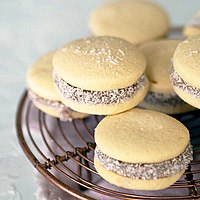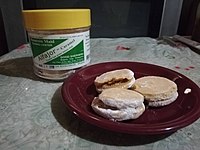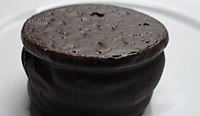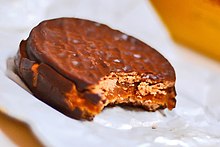 A typical Argentine-style alfajor | |
| Alternative names | Alfajores |
|---|---|
| Course | Sweet or dessert |
| Place of origin | Spain |
| Serving temperature | Room temperature |
| Main ingredients | Flour, honey, almonds, hazelnuts, dulce de leche |
An alfajor or alajú[1] (Spanish pronunciation: [alfaˈxoɾ], plural alfajores) is a traditional confection[2] typically made of flour, honey, and nuts. It is found in Argentina, Bolivia, Paraguay, the Philippines, Southern Brazil, Southern France, Spain, Uruguay, Peru, Ecuador, Colombia, Venezuela, El Salvador and Chile.[3] The archetypal alfajor entered Iberia during the period of al-Andalus. It is produced in the form of a small cylinder and is sold either individually or in boxes containing several pieces.[4]
Etymology
[edit]According to Spanish philologist and dialectologist Manuel Alvar López, alfajor is an Andalusian variant of the Castilian alajú,[5] derived from the Arabic word الفَاخِر, al-fakhir, meaning luxurious, and, contrary to some beliefs that it originated in the New World, was introduced to Latin America as alfajor.[6][7] The word had been introduced into Spanish dictionaries in the 14th century.[8]
The publication of historical dictionaries of the Spanish language allows one to document both forms of the original alajur, written as alajú and alfajor. Alajur and multiple geographic variations are sweets made of a paste of almonds, nuts, breadcrumbs and honey.[9] It is possible that alfajor and alajú were Arabisms introduced into the Spanish language in different places and times, and, supposing both came from the same etymology, from a linguistic point of view, alajú is probably an Arabism of Castillian Spanish, and so it is still alive in Cuenca, Toledo, Guadalajara and in la Sierra de la peña de Francia; meanwhile the variation alfajor is Andalusian and Murcian.[10] In the Americas, the word alfajor was not known until the 19th century.[11]
History
[edit]A similar sweet called alaú is found in the Arabic-Hispanic cookbook Kitab al-Tabikh, by an anonymous author.[citation needed] The Spanish grammarian Nebrija noted the word for the first time in his Latin-Spanish Dictionary (1495) as: alfaxor or alaxur.[8] In the 12th century, Raimundo Martin describes in his book Vocabulista another possible etymology of the Hispano-Arabic fasur, meaning "nectar".[citation needed]
Preparation and presentation
[edit]The regulations of the Andalusian Ministry of Agriculture allow the use of only pure honey, almonds, nuts, breadcrumbs, sugar, flour and spices, such as aniseed, sesame, cilantro, cloves and cinnamon. The Protected Geographical Indication alfajores are meant to be presented in a cylindrical shape, with a minimum weight of 30 grams each, and with a minimum size of about 7 cm in length and a diameter of 1.5 cm. Each of them will be protected with a wrapping paper, and the ends made an ornament in a spiral shape with a ribbon out of the same paper. Once individually wrapped, they may be packaged in wood or cardboard boxes, but never in plastic.[12]
Europe
[edit]In Spain
[edit]
In Spain, there are a variety of different recipes for preparing alfajores, but the most traditional contain flour, honey, almonds and several spices, such as cinnamon. Alfajores are most commonly sold around Christmas, but in Medina Sidonia, they are available year-round.[13][14] The traditional Spanish alfajor has been produced in this town (where it is called an alajú) since ancient times, and the recipe has been traditionally handed down from father to son.[15]
Alfajores are still made by craftsmen in Medina Sidonia using natural ingredients that include honey, almonds, hazelnuts, sugar, flour, and breadcrumbs, and mixed with natural spices.[15] The manufacturing process has been respected following a recipe found by Mariano Pardo de Figueroa in 1786.[16] In Medina Sidonia, the annual production of approximately 45,000 kilograms is mostly consumed in the province of Cadiz, but they are also famous in Sevilla, Malaga and Huelva.[17]
On 15 September 2004, protected geographical indication was ratified by the Consejo de agricultura y pesca de la junta de Andalucía[18] and published in the Official Journal of the European Union as Alfajor de Medina Sidonia on 6 March 2007.[19]
In the province of Cuenca, Spain, where the alfajor is called alajú it is made with almond, honey and figs, all wrapped in a wafer.[20] Medina Sidonia was the capital for the Arabic world of confection, where the alfajor has centuries of history with a recipe that has been transmitted from generation to generation.[21] In this town, there is an account of Mariano Pardo de Figueroa, a gastronomist better known by his pseudonym Doctor Thebussem, who documented the history of this sweet, wherein he wrote that on 2 July 1487, Enrique de Guzmán, second count of Medina Sidonia, ordered the council and majors of the region to send to Malaga 50 cows, 50 oxen, 200 calves and provision of alajú from his city.[22]
The recipe documented by the accounts of Thebussem in the 19th century is defined as the following:
For the alfajor or alajú styling, prepare what I say: one quart of white honey, three means of a pound of hazelnuts and almonds, all roasted and chopped, half ounces of cinnamon, two ounces of aniseed, four drachms of cloves and a quarter of cilantro, roasted and ground coffee, a pound of roasted sesame, eight pounds of dust from grinding, out of bagels without salt or yeast, overcooked in the oven, with half a pound of sugar.[23]
In the Americas
[edit]In the Caribbean
[edit]In Puerto Rico, they underwent creolization, lost their almond and gained ground cassava. They can take varying amounts of sugar and spices. It's possible that Puerto Rico's most common version of this dessert (South American version with dulce de leche) reached Puerto Rico from Venezuela, but the opposite is also possible. Depending on region some add cornstarch, citrus zest, ginger and honey, filled with chocolate, vanilla cream, dulce de leche, fruit paste, or coconut. The filling can be mixed with almonds, sesame seeds, coconut flakes, or sprinkles. Traditional "alfajores" in Argentina, Peru, Uruguay and Venezuela consist of two round, sweet biscuits made of wheat flour or corn starch joined with dulce de leche (known as "manjar blanco" in Peru and as "arequipe" in Venezuela), and optionally coated with powdered sugar. More modern "industrial" varieties in Uruguay and Argentina, are coated with dark or white chocolate (many alfajores are sold in "black" and "white" versions), or simply covered with powdered sugar. These are also known as a Chilean Oreo. One variation is called "alfajor de nieve" (snow alfajor) and has a white coating consisting of a mixture of egg whites and sugar. Most alfajores come packaged in aluminium foil. Alfajores are made in various diameters and are consumed as snacks.
In South America
[edit]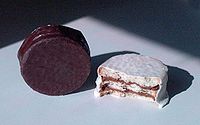
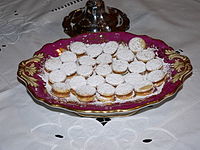
Alfajores have been popular in Argentina and Uruguay since the mid-19th century. However, these differ from the Spanish alfajores in that they are made with two round cookies with different sweet fillings between them. The filling is usually dulce de leche, although there are many variations. They can be covered with powder sugar (the traditional ones), glazed sugar (Santafesinos or "de nieve"), grated coconut or chocolate. Argentina is one of the world's largest consumer of alfajores,[24] both in total numbers and in per capita calculations, actually consuming more than a billion alfajores a year,[25] while being the most common snack for schoolchildren and adults.[24]
Some of the best-known alfajor brands in South America are the Argentine "Balcarce", "Jorgito", "Capitán del Espacio", "Guaymallen", "Suchard", "Havanna", "Cachafaz", "Juanote" and "Estancia El Rosario",[26] the Uruguayan "Punta Ballena", "Sierra de Minas", "Alfajores Portezuelo", "Marley", and Peruvian "Casa del Alfajor".
In Argentina
[edit]The alfajor has been manufactured and consumed since colonial times[27] in the territories that today belong to Argentina.[28]
It is understood as Alfajor the product made up of two baked cookies adhered to each other by other products such as marmalade, jellies, sweet or other substances or alimentary mixed substances of permitted use. These could be partially or totally covered or coated with confectionery substances and they could contain entire or divided dried fruits, grated coconut or garnishes whose constituents are admitted herein Code. (...)
— Section 761 bis
Industrial alfajor
[edit]Mass-production of alfajores[29] traces back to the Atlantic coast of Argentina in the 1950s. Brands such as Havanna and Balcarce, and as many as 30 others, have been introduced into shops and supermarkets. Statistics of the year 2021 shows that inhabitants of Argentina consume 6 million alfajores per day.[30] Supermarkets carry a wide variety of product, up to 34 different kinds. These include "triple alfajores", which are composed of three biscuits adhered to one another with dulce de leche and covered with chocolate.[31]
Regional
[edit]Around 1851 in the district of Arocena (province of Santa Fe), Manuel Zampatti, known as Zapatin, began commercially manufacturing an existing variety of alfajor consisting of three baked cookies adhered with dulce de leche and coated with sugar. These came to be known as "alfajor santafesino". Colonel Néstor Fernández took it to the battle of Caseros, and was there when the army tasted it and it became so popular that General Justo José de Urquiza had alfajores taken to his San José de Entre Ríos farm with a weekly load of these alfajores.[32] They are also manufactured in the provinces of Santiago del Estero and Tucumán, and the famous brand Havanna manufactures them in the city of Mar del Plata and in most of the tourist places of Argentina.
The Cordobes alfajor stands out among the regional varieties of Argentina; it is filled with jellies of fruits (generally of quince), one of the most well - known brands is Estancia El Rosario.[33] Other outstanding variety is the alfajor from Santa Fe which has no less than three puff pastry covers adhered to one another with much dulce de leche and everything glazed (Industrial preparations can be differentiated because they are not coated in the lower part, since the coating is made in plates).[34] In addition, In Santa Fe, it can be acquired the Rogel, of similar characteristics, but bigger (the size of a small cake) and the variety from Tucuman, which is known as a clarita and it is made up with two crunchy cookies as covers and filled with a jelly made up of sugar molasses. In Argentina, alfajores made up of cornflour are very consumed as well (covers made up of maize starch, filled with dulce de leche and grated coconut around the joining).
In Peru
[edit]Alfajores made their arrival to the Viceroyalty of Peru, the largest administrative district of the Spanish Empire in South America in the 16th century, and have been popular since, especially the artisanal types.[35]
In Chile
[edit]The cornflour alfajor is consumed during the whole year in the central areas of Chile; on the other hand, in the southern areas of Chile, it is consumed another variety of alfajor, generally for Patriotic festivities of September.[36]
The alfajor is basically a sponge cake or cookies adhered with manjar (dulce de leche) and generally coated in meringue or marmalade and optionally with sprinkled icing sugar.[37] Two types of alfajores are mainly outstanding in Chile:
- The first type of alfajor, similar to the one of corn flour prepared in other countries of Latin America, is prepared over all the territory of Chile, and mainly in the central area of Chile, where it is a traditional candy. It is known with other names as "candy of corn flour" or the typical "chilenitos".[38] The chilenitos are manufactured with corn flour or other types of flour and tend to be simpler and smaller than the typical alfajores.
- The second type of alfajor, considered the true traditional alfajor of the country and known as "chilean alfajor", is mainly prepared in the southern areas of Chile. Unlike the traditional alfajores of corn flour, it stands out because it is prepared with two hojarascas (kind of thin and firm cookie) that, since they are previously baked, acquire a curved form in their extremes. They are adhered to each other with dark brown sugar, panela, manjar or with confectioners cream[37] (if they are filled with dark brown sugar, the hojarascas are a little bit thicker and flatter than those filled with manjar). Optionally, they can be garnished in the end of the filling with grated coconut as it is the case of the alfajores filled with manjar or with ground nuts.
Guinness World Record: the biggest South American alfajor
[edit]According to Guinness World Records, the biggest alfajor in the world, measuring almost two meters in diameter and 80 centimeters in height and weighing 464 kilograms, was made on 11 December 2010 in Minas, Lavalleja Department, Uruguay.[39] The giant alfajor was made to mark the celebration of Uruguay's first National Alfajor Festival. More than 30 people participated in the preparation of the record-breaking alfajor.[40]
Gallery
[edit]-
Home-made alfajores made with cornstarch and dulce de leche
-
A jar of alfajores from the city of Baguio, Philippines
-
Dark chocolate alfajor
-
Peruvian alfajor
-
A typical alfajor from Córdoba, Argentina
See also
[edit]- Baklava, a Middle-Eastern confection of layered pastry and honey
- List of desserts
- Macaron, a similar French confection
- Mille-feuille, a French confection of layered pastry and cream
- Pirouline, a cream-filled tubular wafer cookie
- Wagon Wheel (Commonwealth), Choco pie (Korea), and Moon pie (United States), similar snacks with a marshmallow filling
References
[edit]- ^ "El alfajor de Medina Sidonia". José Luis Flores (in Spanish). Retrieved 11 July 2010.
- ^ "Alfajor de Medina Sidonia" (in Spanish). Archived from the original on 11 November 2010. Retrieved 28 September 2010.
- ^ "Ice cream alfajores: What sandwich cookies can be". Linda Shiue. 13 July 2010. Retrieved 2 August 2010.
- ^ "Alfajor de Medina Sidonia". Official Journal of the European Union. Retrieved 17 July 2010.
- ^ "Un capítulo de lexocología gastronómica". Francisco Gómez Ortín (in Spanish). Retrieved 11 July 2010.
- ^ "El andalucismo del español en América". Carmen Marimón Llorca (in Spanish). Retrieved 11 July 2010.
- ^ "El español en América: de la conquista a la Época Colonial". Carmen Marimón Llorca. Retrieved 16 July 2010.
- ^ a b In Antonio de Nebrija's Spanish-Latin Vocabulary (1495): "Alfajor". «Tesoro de los diccionarios históricos de la lengua española» (in Spanish). RAE. Retrieved 29 July 2022.
- ^ Germá Colón; Günter Holtus; Georges Lüdi; Michael Metzeltin (1989). La Corona de Aragón y las lenguas románicas (in Spanish). G. Narr. "Persistencia de las voces" (section. ISBN 9783878083030. Retrieved 16 July 2010.
- ^ Salgado, Felipe Maíllo (January 1998). Los arabismos del castellano en la Baja Edad Media (in Spanish) (3rd Corrected and Expanded ed.). Universidad de Salamanca. ISBN 9788474819939. Retrieved 17 July 2010.
- ^ Guille Segal. "El Alfajor: Sus orígenes, su preparación, su sabor inolvidable" (in Spanish). Archived from the original on 21 July 2011. Retrieved 24 July 2010.
- ^ "Agricultura aprueba las denominaciones de calidad 'Estepa' y 'Alfajor de Medina Sidonia'". Junta de Andalucía (in Spanish). Archived from the original on 7 August 2011. Retrieved 15 July 2010.
- ^ "El alfajor, una receta árabe con historia" (in Spanish). Archived from the original on 15 December 2018. Retrieved 15 July 2010.
- ^ Marta Rangel Marmol (27 October 2008). "El alfajor, una receta árabe que continúa su elaboración en Medina Sidonia" (in Spanish). Retrieved 23 July 2010.
- ^ a b "Gastronomía". Turismo Andaluz S.A. (in Spanish). Retrieved 15 July 2010.
- ^ Granados, Jesús Ávila (2003). Elaboración. Ediciones Robinbook. ISBN 9788496054042. Retrieved 23 June 2010.
- ^ Junta de Andalucía. "IGP Alfajor Medina Sidonia" (PDF). Productos andaluces emblemáticos (in Spanish). Archived from the original (PDF) on 23 July 2011. Retrieved 15 July 2010.
- ^ "BOE núm 8" (PDF). Ratificación del Reglamento de la Indicación Geográfica Protegida "Alfajor de Medina Sidonia" (in Spanish). Retrieved 2 June 2021.
- ^ "Legislation" (PDF) (in Spanish). Archived from the original (PDF) on 14 November 2017. Retrieved 16 July 2010.
- ^ Eduardo González Viaña (25 January 2010). "La guerra de los alfajores" (in Spanish). Archived from the original on 9 March 2012. Retrieved 15 July 2010.
- ^ "Alfajor de Medina Sidonia, un dulce tradición de origen árabe". Fátima Fernández (in Spanish). 15 December 2008. Retrieved 14 July 2010.
- ^ Thebussem (5 November 1881). "La ilustración española y americana" (PDF) (in Spanish). Retrieved 15 July 2010.
- ^ "Alfajor de Medina Sidonia y Mantecados de Estepa aúnan tradición y calidad". EFEAGRO (in Spanish). Archived from the original on 10 July 2011. Retrieved 23 July 2010.
- ^ a b Samela, Gabriela (3 April 2016). "En el país se consumen más de mil millones de alfajores por año". Clarín (in Spanish). Retrieved 19 October 2021.
- ^ "The Alfajor, a nation's passion". Retrieved 30 July 2021.
- ^ El Rosario, Estancia. "Alfajores Estancia El Rosario". Estancia El Rosario. Archived from the original on 24 August 2000. Retrieved 28 July 2021.
- ^ "History of Argentina, pre-columbian, colonial, period, independence, Peron". www.latinamericacollection.com. Archived from the original on 21 September 2021. Retrieved 21 September 2021.
- ^ Félix, Luna (2015). "BREVE HISTORIA SOCIEDAD ARG (2 ed - 1er cap)" (PDF). Archived (PDF) from the original on 7 January 2018.
- ^ "Producción de alfajores". www.alimentosargentinos.gob.ar. Retrieved 19 October 2021.
- ^ "Comenzó la semana del alfajor: cuáles son los más buscados por los argentinos". Todo Noticias (in Spanish). 2 May 2022. Retrieved 2 August 2022.
- ^ Origlia, Gabriela (18 March 2021). "Alfajor triple: la historia de un clásico que nació en la Argentina". La Nación (in Spanish). ISSN 0325-0946. Retrieved 19 October 2021.
- ^ "Alfajor Argentino - HISTORIA". www.alfajor-argentino.com.ar. Retrieved 19 October 2021.
- ^ Origlia, Gabriela (26 June 2018). "La historia del alfajor cordobés que tiene casi 100 años y nunca pasó por un kiosco". La Nación (in Spanish). ISSN 0325-0946. Retrieved 19 October 2021.
- ^ Emanuel (9 April 2021). "¿Cuál es el real origen del alfajor santafesino?". SOL 91.5 (in Spanish). Retrieved 19 October 2021.
- ^ "The Easy Lima Guide: Alfajores - Typical Peruvian Manjar Blanco filled Cookies". Retrieved 26 March 2019.
- ^ "¡Vivan los alfajores de Chancaca!". El Naveghable.cl, Noticias de Valdivia y Los Ríos (in Spanish). Retrieved 19 October 2021.
- ^ a b "Guia Chiletur Copec | Rutas de norte a sur y cientos de datos turísticos para viajar por Chile". 21 January 2014. Archived from the original on 21 January 2014. Retrieved 19 October 2021.
- ^ S.A.P, El Mercurio (3 June 2015). "Merkén, jugo de maqui y chilenitos: Los productos nacionales más solicitados en Expo Milán | Emol.com". Emol (in Spanish). Retrieved 19 October 2021.
- ^ Guinness World Records. "Largest Alfajor". Retrieved 21 April 2012.
- ^ Bonhomme, Fernando (10 June 2011). "Guinness reconoció el alfajor más grande del mundo: pesa 464 kilos". El País (Uruguay). Retrieved 21 April 2012.
